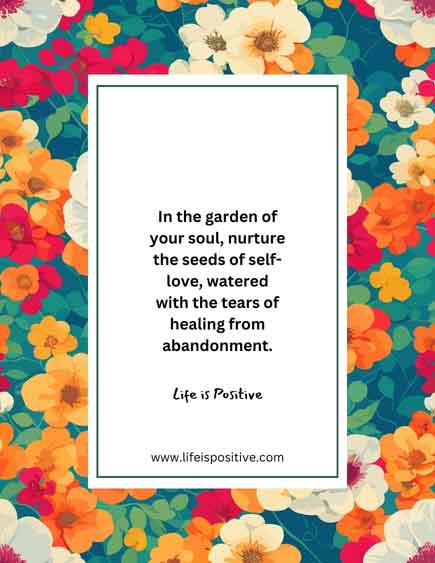|
Getting your Trinity Audio player ready...
|
Ever felt like those childhood abandonment issues are cramping your style?
We’ve all got our baggage, but when it feels like these issues are the unwanted guests at our life party, it’s time to kick them out.
Remember, you’re not alone in this boat of navigating the stormy seas of your past.
Whether it’s a distant memory or a relationship that didn’t quite pan out, we’re all in the same boat.
We understand that it takes courage and vulnerability to confront the knots of your past and create a new story for your future.
We are here to support you every step of the way on this journey toward healing and growth.
So, how do you shake off those childhood abandonment issues and sail towards smoother waters?
Get ready for our ten practical tips on how to overcome abandonment issues from childhood.
Let’s work together to make positive changes in your life and help you move forward with confidence and hope.
Unpacking the Emotional Baggage
We all carry around a suitcase of experiences, right? But when it feels like childhood abandonment issues have set up camp in there, it’s time for some unpacking.
No worries; we’ve got the tools to navigate this maze together.
Now, let’s get to the crux of it. How do you overcome abandonment issues from childhood and steer your ship towards smoother waters?
It’s not about forgetting the past; it’s about rewriting its influence on your present and future.
Let’s explore ten practical tips on how to overcome abandonment issues from childhood.
1. Understanding the Roots
To conquer any issue, you need to understand its roots. Childhood abandonment issues often sprout from early experiences that shape our view of trust and security.
By acknowledging and understanding these roots, you’re already taking the first step toward healing.

Remember, it’s not about staying stuck in the past but shining a light on it with kindness and understanding.
By recognizing and understanding these beginnings, you’re like a superhero taking the first step to feeling better.
2. Embrace Your Feelings
Embracing our emotions is akin to hosting unruly guests within ourselves—they demand attention, and suppressing them can lead to emotional clutter.
Specifically, when dealing with feelings of abandonment, it’s crucial to acknowledge them rather than bottling them up.

Allowing ourselves to feel, express, and release these emotions is akin to providing them with a passport out of our emotional baggage.
This approach fosters emotional well-being and prevents the buildup of unresolved sentiments.
So, welcome your emotions as temporary guests, granting them the freedom to depart, leaving you with a lighter emotional load.
3. Seek Professional Support
In the midst of life’s tempests, acknowledging that some storms are too intense to navigate solo is an act of wisdom.
Opting for professional help isn’t a sign of weakness; rather, it’s a profound testament to one’s strength and commitment to healing.

Picture a therapist as your guiding lighthouse in the storm, offering invaluable insights and equipping you with the tools needed to navigate the choppy waters of your emotions and challenges.
Seeking support is a brave decision, aligning with the notion that true strength lies in the ability to recognize when assistance is essential for personal growth and well-being.
4. Cultivate Self-Compassion
Picture conversing with yourself as you would with a cherished friend facing challenges—that’s the essence of self-compassion.
Embrace kindness towards your own journey of overcoming childhood abandonment issues, understanding that it’s a gradual process rather than an instant remedy.

Acknowledge the strides you make, no matter how minor, and celebrate your progress. Each step forward is a testament to your resilience and commitment to personal growth.
By extending the same empathy to yourself as you would to a dear friend, you cultivate a nurturing environment for healing, fostering a positive relationship with your past and present self.
5. Rewrite Your Narrative
Your past is a sculptor, not a jailer—it doesn’t define you but molds you. Seize the pen and embark on rewriting your narrative.
Direct your focus towards the strengths and resilience cultivated in response to challenges.
You’re not a victim of circumstances; you’re the heroic protagonist of your story.
Embrace the transformative power within, for every trial has contributed to the evolution of your character.

It’s important to acknowledge your agency in shaping your own narrative.
It allows you to reclaim authorship over your life and tell a story that emphasizes your triumphs and growth.
By doing so, you can move away from a narrative rooted in victimhood and instead focus on empowerment and resilience.
Remember, you are not defined by what happens to you but rather by how you choose to respond to it.
6. Build Healthy Relationships
In the intricate dance of relationships, the shadow of abandonment issues can complicate the steps. Redirect your focus towards cultivating healthy connections.
Foster open communication to bridge understanding, establish clear boundaries to safeguard your emotional well-being, and curate a supportive circle.

Surround yourself with individuals who uplift and bolster your journey, creating a network that becomes a sanctuary of trust and understanding.
By proactively engaging in these practices, you not only navigate relationships more skillfully but also pave the way for genuine connections that thrive on mutual respect and support, casting aside the shadows of abandonment for the warmth of authentic bonds.
7. Practice Mindfulness
It’s important to embrace the present moment as a precious gift and practice mindfulness to skillfully unwrap it.
Take a deep breath and ground yourself in the present moment, letting go of your worries about the past.
Mindfulness is a powerful tool that allows you to fully enjoy each moment.
By immersing yourself in the present, you can free yourself from the constraints of past experiences and become more aware of your surroundings.

This practice becomes a guiding light, gently leading you toward a deeper connection with the current moment.
It is a therapeutic escape from the burdens of yesterday and an invitation to relish the beauty and potential held within the now.
Remember to be kind to yourself and take things one step at a time.
8. Celebrate Independence
Embrace the journey of rediscovering your independence. Immerse yourself in activities that not only bring joy but also evoke a sense of accomplishment.
Whether it’s dedicating time to a cherished hobby, acquiring a new skill, or relishing your own company, celebrate the liberating essence of being authentically you.

Reconnecting with your passions and investing in personal growth fosters a profound sense of freedom.
This journey becomes a testament to your resilience and an affirmation of the vibrant, self-sufficient individual you are becoming.
So, revel in the empowerment that arises from cultivating a fulfilling and authentic life on your terms.
9. Challenge Negative Beliefs
Confront the negative beliefs stemming from abandonment issues by questioning their roots. Are they grounded in factual evidence or distorted perceptions?
Challenge these self-limiting thoughts and embark on a transformative journey of self-affirmation.
Recognize your intrinsic worthiness of love, trust, and meaningful connections.

Replace the shadows of doubt with empowering beliefs that reflect your true value.
The narrative you construct about yourself and relationships holds the power to reshape your reality.
Embrace the truth that you deserve the richness of genuine connections, and let go of the constraints that inhibit your capacity to experience the love and trust you inherently deserve.
10. Foster Resilience
Life’s storms can be harsh, especially when rooted in childhood abandonment. To foster resilience, embark on a transformative journey of self-healing.
Begin by acknowledging the pain, allowing yourself to feel without judgment. Build a support network, confide in trusted allies, or seek professional guidance.
Transform setbacks into stepping stones, viewing challenges as opportunities for growth. Cultivate self-compassion, understanding that healing is a gradual process.

Set healthy boundaries, protecting your emotional sanctuary. Embrace change, viewing it as a catalyst for personal evolution.
Resilience isn’t about erasing scars but crafting a narrative where survival becomes triumph, turning the echoes of abandonment into the melody of empowerment.
Final Thoughts
As we reach the end of our journey of how to overcome abandonment issues from childhood, it’s important to remember that you’re not alone, and your story is uniquely yours.
I understand that embracing resilience isn’t a quick fix; it’s a daily commitment to your well-being.
It’s okay to feel overwhelmed but remember, you are strong and capable.
Start by being your own superhero—acknowledge the hurt, surround yourself with love, and dance through the storms of self-discovery.
Remember, I believe in you!
Life’s playlist may have had a few dissonant chords, but now, you’re composing a melody of strength.
So, how do you overcome abandonment issues from childhood? By writing your anthem of triumph and resilience—one verse at a time.
Remember, you are brave and capable and deserve all the love and support in the world.
For more empowering content, connect with our vibrant community here ➡️ Social Media.

